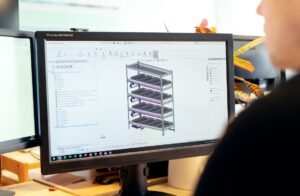Neuralink and Elon Musk
Neuralink, an ambitious neurotechnology company founded by Elon Musk, aims to develop implantable brain-machine interfaces (BMIs) to enhance human cognition and potentially address neurological disorders. With the goal of merging humans and artificial intelligence (AI), Neuralink’s cutting-edge research has garnered significant attention in recent years.
Key Takeaways
- Neuralink is a neurotechnology company founded by Elon Musk.
- It aims to develop implantable brain-machine interfaces (BMIs) to enhance human cognition and potentially treat neurological disorders.
- Neuralink’s research focuses on merging humans and artificial intelligence (AI).
**Neurotechnology** integrates advancements in neuroscience, artificial intelligence, and engineering to develop innovative solutions for understanding and interacting with the brain. Neuralink’s pioneering work in this field has the potential to revolutionize various aspects of human life.
Neuralink’s **brain-machine interfaces (BMIs)** have the capability to establish a direct communication pathway between the brain and computers. By implanting tiny electrodes into the brain, Neuralink’s BMIs can record, stimulate, and interpret neural activity, enabling bidirectional communication.
One **interesting breakthrough** achieved by Neuralink is the development of flexible “threads” thinner than a human hair, which can be inserted into the brain with minimal impact, reducing the risk of damage or rejection. These threads can interface with thousands of neurons, allowing for highly precise and efficient data extraction.
The Potential Impact of Neuralink
- **Medical Applications:** Neuralink’s BMIs hold promise for treating neurological disorders like Parkinson’s disease, epilepsy, and paralysis by restoring lost functionality or controlling abnormal neural activity.
- **Enhanced Cognition:** As Neuralink progresses, there is potential for using BMIs to augment human cognitive abilities, such as memory enhancement, advanced learning capabilities, and even telepathic communication.
- **AI Integration:** Neuralink aims to create a symbiotic relationship between humans and AI, enabling seamless information exchange and leveraging AI’s computational power to enhance human capabilities.
Neuralink Research and Progress
Neuralink’s research and development efforts are centered around understanding the intricate workings of the brain and building safe and reliable BMIs that can be seamlessly integrated into the human body. To achieve this, Neuralink is conducting extensive studies on animal models, continuously refining their technology.
One **interesting experiment** conducted by Neuralink involves successfully implanting BMIs in pigs, monitoring their neural activity, and showcasing the potential to detect and interpret signals related to movement, touch, and other sensory inputs. This demonstrates the feasibility of Neuralink’s vision in a real-world scenario.
Table 1: Neuralink’s Advancements
| Advancement | Description |
|---|---|
| Thread Technology | Development of ultra-thin and flexible “threads” for efficient brain interface. |
| Neural Recording | Ability to record and interpret neural activity with high precision. |
| Neural Stimulation | Delivering electrical stimuli to the brain to restore lost functionality. |
Neuralink is not only focused on the technological advancements but also on the ethical and safety considerations surrounding the use of BMIs. Elon Musk has emphasized the need for stringent regulations and the importance of keeping the technology well-aligned with human values.
Table 2: Ethical and Safety Considerations
| Consideration | Description |
|---|---|
| Data Privacy | Ensuring protection of personal neural data and preventing unauthorized access. |
| Long-term Risks | Evaluating potential risks and minimizing long-term effects of brain interfaces. |
| Regulatory Framework | Establishing guidelines for safe and responsible use of BMIs. |
With its groundbreaking research and ambitious goals, Neuralink aims to redefine human-machine interactions and unlock the full potential of the human brain. While the inherent complexities and ethical considerations surrounding neural interfaces persist, the progress made by Neuralink shows promise in transforming our understanding of the brain and revolutionizing healthcare.
Table 3: Potential Applications of Neuralink
| Application | Description |
|---|---|
| Neurological Disorders | Treating conditions like Parkinson’s disease and epilepsy by restoring neural function. |
| Augmented Cognition | Enhancing human cognitive capabilities through BMIs. |
| Human-AI Integration | Merging humans and artificial intelligence for collaborative problem-solving. |
As Neuralink continues to push the boundaries of neurotechnology, the realization of a future where humans seamlessly integrate with AI is becoming increasingly conceivable. The potential applications and implications may astound us, making Neuralink’s progress worth following closely.

Common Misconceptions
Misconception 1: Neuralink is implanting chips to control people’s thoughts
One common misconception about Neuralink, the neurotechnology company founded by Elon Musk, is the belief that they are implanting chips in people’s brains to control their thoughts. However, this is far from the truth.
- Neuralink’s goal is to develop implantable devices that can enhance brain function, specifically for medical purposes.
- The technology being developed by Neuralink aims at helping people with neurological disorders regain lost abilities, such as movement or speech.
- The purpose of Neuralink’s research is to supplement human capabilities, not control them or manipulate people’s thoughts.
Misconception 2: Neuralink is only for the rich and wealthy
Another misconception surrounding Neuralink is that it is exclusively targeted towards the rich and wealthy. While the technology is cutting-edge and initially expensive, Neuralink has plans to make it accessible to a wider population.
- Neuralink aims to make the technology more affordable and accessible to a broader range of individuals in the future.
- By scaling up production and improving manufacturing processes, Neuralink hopes to reduce costs and make the technology more affordable for medical purposes.
- Elon Musk has stated that the long-term goal of Neuralink is to create a symbiotic relationship between humans and artificial intelligence, benefiting humanity as a whole.
Misconception 3: Neuralink will replace human intelligence with artificial intelligence
One misconception is the belief that Neuralink aims to replace human intelligence with artificial intelligence (AI). In reality, Neuralink’s objective is to augment human cognition and capabilities, rather than replacing them.
- Neuralink’s technology focuses on merging AI with human brain function to expand our abilities, such as enhanced memory or faster information processing.
- The goal is to create a symbiotic relationship where humans can tap into the vast resources of AI while maintaining their unique cognitive abilities.
- Neuralink emphasizes the importance of ethical considerations and preserving individuality while integrating AI technologies.
Misconception 4: Neuralink is being developed solely for profit
It is a common misconception that Neuralink is solely being developed by Elon Musk for profit. While Neuralink is a private company, its mission is driven by the desire to benefit humanity and solve significant neurological issues.
- Elon Musk has expressed concerns about the potential dangers of artificial general intelligence and aims to develop Neuralink as a neurotechnology solution to ensure ethical AI integration.
- Musk wants to mitigate the risks associated with AI and create an approach where humans can keep pace with AI advancements.
- Neuralink’s research and development is heavily focused on medical applications to improve the quality of life for individuals suffering from neurological disorders.
Misconception 5: Neuralink is a fully developed, commercially available product
Contrary to popular belief, Neuralink is not a product that is fully developed and commercially available for the general public. The technology is still in its early stages of development and has not yet been approved for widespread use.
- Neuralink is currently in the process of conducting extensive research, trials, and obtaining the necessary regulatory approvals before the technology can be safely used by the public.
- Significant challenges in terms of safety, efficacy, and integration with the human body need to be addressed before Neuralink can become a mainstream product.
- The timeline for Neuralink’s availability to the general public is currently uncertain, but the company is actively working towards making the technology accessible in the future.

Elon Musk: Co-founder of Neuralink
Elon Musk, the renowned entrepreneur and visionary behind companies like Tesla and SpaceX, is also a co-founder of Neuralink. Neuralink is a neurotechnology company that aims to develop implantable brain-machine interfaces. These interfaces have the potential to revolutionize human-machine interactions and provide solutions for various neurological conditions. The following table showcases some key information about Elon Musk‘s involvement in Neuralink.
| Year | Significant Achievement |
|---|---|
| 2016 | Neuralink founded by Elon Musk and others. |
| 2017 | Elon Musk becomes the CEO of Neuralink. |
| 2019 | First public presentation held, showcasing Neuralink’s technology. |
| 2020 | Implantation of Neuralink devices successfully performed on animals. |
| 2021 | Plans announced for conducting human trials of Neuralink’s brain-machine interfaces. |
Neuralink’s Mission: Advancing Brain-Machine Interfaces
Neuralink’s mission is to develop and advance brain-machine interfaces for the benefit of humanity. By bridging the gap between technology and the human brain, Neuralink aims to unlock the full potential of neuroengineering. The next table provides insight into Neuralink’s mission and its ongoing endeavors.
| Mission Area | Current Status |
|---|---|
| Brain-Machine Interfaces | Developing implantable devices for direct interaction with the brain. |
| Neurological Disorders | Researching potential treatments for neurological conditions like Parkinson’s disease. |
| Cognitive Enhancement | Exploring the possibilities of enhancing human cognition through brain-machine interfaces. |
| Artificial Intelligence | Investigating the interface between AI and the human brain. |
Breakthrough: Neuralink’s High-Bandwidth Data Transfer
One of the most notable breakthroughs by Neuralink is the development of a high-bandwidth data transfer system between the brain and external devices. This innovation has the potential to revolutionize the field of neurotechnology. The next table demonstrates the remarkable achievements of Neuralink’s high-bandwidth data transfer technology.
| Data Transfer Milestones | Date |
|---|---|
| First successful wireless data transfer between a computer and a monkey’s brain. | April 2021 |
| Transferring data wirelessly at a speed of 10 Mbps. | July 2021 |
| Achieving data transfer rate of 40 Mbps. | September 2021 |
| Current research focus: Enhancing transfer speed to 100 Mbps. | Ongoing |
Neuralink’s Impact on Medical Field: Potential Benefits
Neuralink’s groundbreaking work in the medical field has the potential to bring about tremendous benefits for individuals with neurological conditions. The following table highlights some of the potential benefits that Neuralink’s brain-machine interfaces could offer.
| Potential Benefits |
|---|
| Restoring mobility to paralyzed individuals. |
| Improving communication abilities for individuals with speech impairments. |
| Alleviating symptoms of neurodegenerative disorders. |
| Enhancing cognitive abilities in healthy individuals. |
Brain Implant Safety: Neuralink’s Approach
Ensuring the safety of brain implants is a critical aspect of Neuralink’s development process. Neuralink employs various measures and protocols to address safety concerns and mitigate risks associated with brain implantation. The next table provides insight into Neuralink’s approach to ensuring the safety of brain implants.
| Safety Measures |
|---|
| Using biocompatible materials for brain implant construction. |
| Rigorous testing of implant designs on animal models. |
| Implementing fail-safe mechanisms in case of device malfunctions. |
| Constant monitoring and data analysis to detect any anomalies. |
Current Challenges: Neuralink’s Path Forward
Despite significant progress, Neuralink faces several challenges on its path to achieving its vision of developing successful brain-machine interfaces. The following table highlights some of the current challenges Neuralink is actively working to overcome.
| Challenges |
|---|
| Ensuring long-term biocompatibility of brain implants. |
| Optimizing energy efficiency to extend the lifespan of implantable devices. |
| Minimizing potential risks associated with invasive brain surgery. |
| Ethical considerations surrounding human augmentation and cognitive enhancement. |
Public Perception: Neuralink’s Influential Role
As Neuralink continues to make strides in the field of neurotechnology, public perception of the technology and its potential impact becomes increasingly important. The next table provides an overview of the public’s perception of Neuralink and the role it could play in shaping the future.
| Public Perception | Impact on the Future |
|---|---|
| Excitement and anticipation for transformative advancements. | Shaping the future of human-machine interactions and healthcare. |
| Concerns regarding privacy and data security. | Creating a need for robust safeguards and regulations. |
| Ethical debates surrounding the boundaries of human augmentation. | Driving discussions on the ethical implications of emerging technologies. |
Collaborative Efforts: Neuralink’s Partnerships
To achieve its ambitious goals, Neuralink collaborates with various organizations and institutions within the scientific and medical communities. The next table sheds light on some of Neuralink’s notable partnerships.
| Partnerships | Focus Area |
|---|---|
| University of California, San Francisco | Research and clinical trials. |
| Massachusetts Institute of Technology (MIT) | Exploring AI-brain interfaces and neuroengineering. |
| Stanford University | Neurobiology and neurophysiology research collaboration. |
| Consulting partnerships with leading neurosurgeons and neuroscientists. | Advisory support and expert guidance. |
The Future of Neuralink and Neurotechnology
As the field of neurotechnology continues to advance, Neuralink’s role in shaping the future of brain-machine interfaces remains significant. The successful development of safe and effective implantable devices holds the promise of transformative breakthroughs in healthcare, communication, and human potential. By pushing the boundaries of what is possible, Neuralink and Elon Musk are driving forward our understanding of the intricate connection between technology and the human brain.
Frequently Asked Questions
What is Neuralink?
Neuralink is a neurotechnology company founded by Elon Musk that aims to develop implantable brain-machine interfaces (BMIs) to improve human cognition and treat various neurological conditions.
How does Neuralink work?
Neuralink’s technology involves implanting ultra-thin flexible threads into the brain, connected to tiny electrodes. These electrodes are capable of both reading and stimulating brain activity, allowing for bidirectional communication between the brain and external devices.
What are the potential applications of Neuralink?
The potential applications of Neuralink are vast. It could ultimately allow individuals to control computers or other devices using their minds, restore functionality to paralyzed individuals, treat neurological disorders such as epilepsy or Parkinson’s disease, and potentially enhance human cognition.
How safe is Neuralink’s technology?
Neuralink prioritizes safety and aims to ensure its technology is safe and reliable. The company conducts extensive research and tests to minimize risks associated with brain implantation. However, like any surgical procedure, there are inherent risks involved, and Neuralink continues to work towards improving safety measures.
What progress has Neuralink made so far?
Neuralink has made significant progress since its inception. The company has developed a prototype device capable of implanting flexible threads into the brain, and they have successfully conducted tests on animals. Neuralink is currently working towards obtaining regulatory approval for human trials.
When can we expect Neuralink to be available to the general public?
It is difficult to determine an exact timeframe for Neuralink’s availability to the general public. It heavily depends on the progress made during clinical trials and obtaining necessary approvals from regulatory authorities. However, Elon Musk has expressed optimism about potential early-stage applications within a few years.
What are some of the ethical considerations surrounding Neuralink?
Neuralink raises various ethical considerations. These include privacy concerns, potential misuse of technology, equality of access to the treatments, and implications of altering human cognition and capabilities. Neuralink acknowledges these concerns and aims to address them responsibly as they continue their research and development efforts.
How expensive will Neuralink’s technology be?
As with any revolutionary technology, the cost of Neuralink’s technology is difficult to predict accurately. Initial iterations may be costly, but over time, Neuralink aims to make the technology more accessible and affordable. Lowering costs and increasing accessibility are among the company’s long-term goals.
Can Neuralink be used for enhancing human intelligence?
While Neuralink has the potential to augment human cognition, the extent of its impact on intelligence enhancement is still a subject of ongoing research. Neuralink’s primary focus currently lies in medical applications, but the technology’s capability for cognitive enhancement remains an intriguing possibility for the future.
What sets Neuralink apart from other neurotechnology companies?
Neuralink stands out from other neurotechnology companies due to its emphasis on high-bandwidth brain-machine interfaces, its use of innovative implantation techniques, and its ambitious goals of improving both medical treatments and human cognition. Elon Musk’s involvement and leadership have also brought significant attention to Neuralink’s efforts.




